Results 1 to 10 of 149
-
07-15-2013, 05:35 PM #1
 Any Info On This: "The Griffon Strop Aide" ??? See Pictures:
Any Info On This: "The Griffon Strop Aide" ??? See Pictures:
Hey All...
I found this sometime ago at a garage sale. It's called a 'Griffon Strop Aide' but I haven't a CLUE as to it's purpose or how or why it might work as advertised. Anyone out there with any information would be appreciated...
Here are some pics including a pic of an old advertisement that I found when trying my hand at research on the internet. Interesting to say the least...
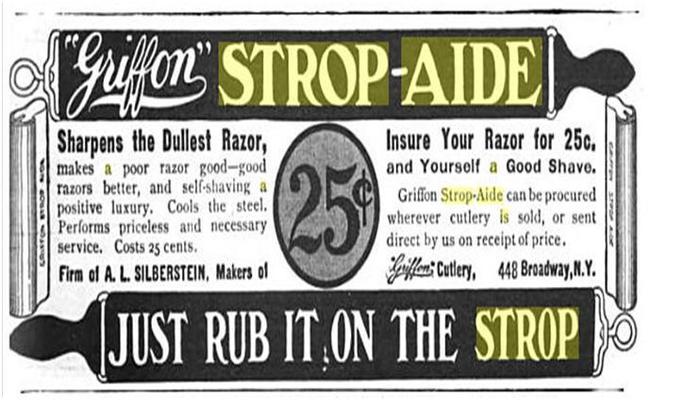
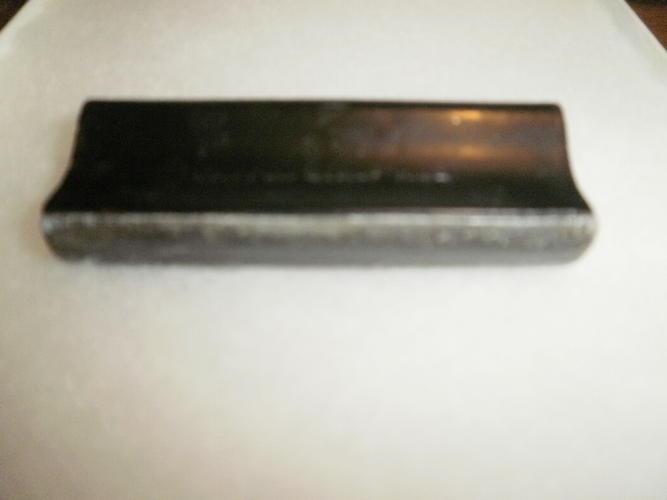
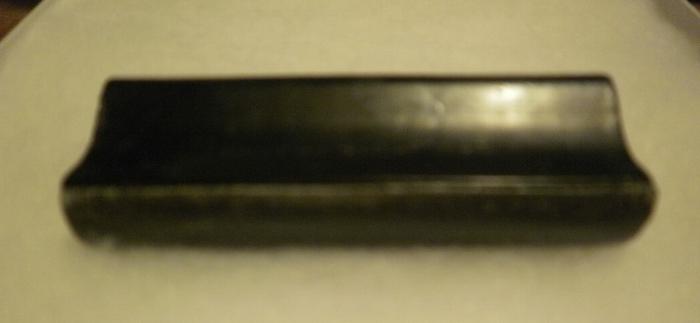
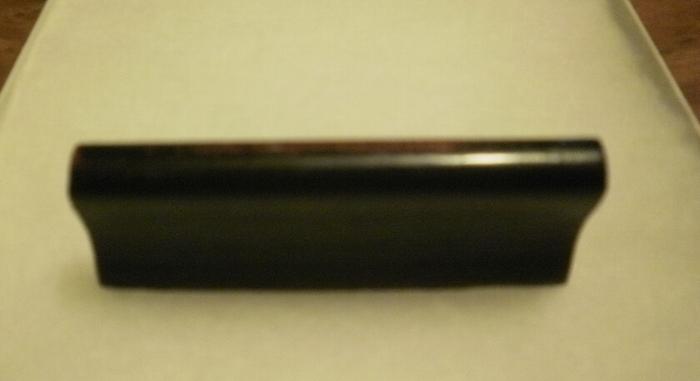
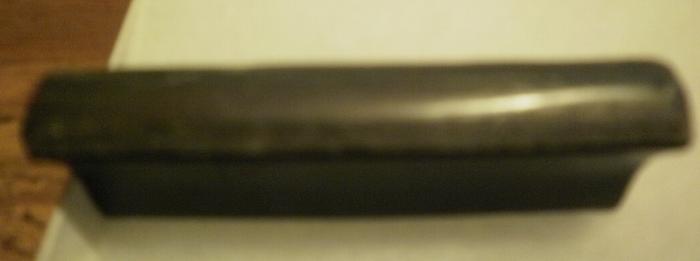
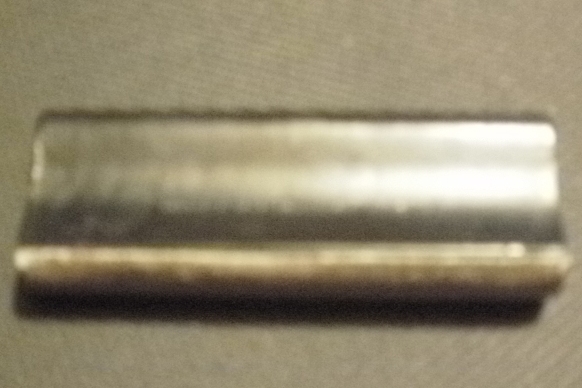
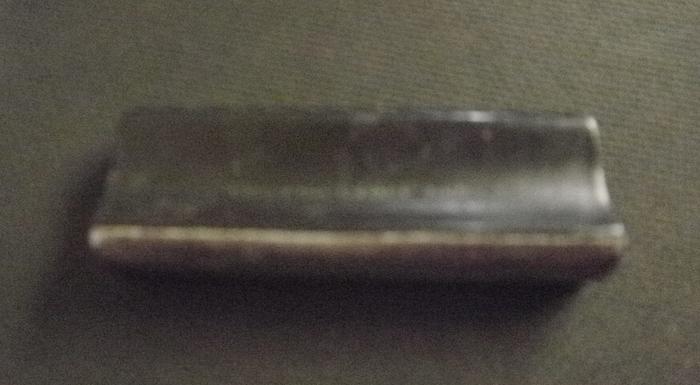
The 'working' edge that I assume you rub on a strop looks to be made of a lead alloy. It can be easily scratched with a fingernail so it is somewhat soft.
Sorry about the quality of the pics...my camera 'SUCKS'...
WP34
-
The Following User Says Thank You to Wolfpack34 For This Useful Post:
Phrank (06-19-2015)
-
07-15-2013, 06:03 PM #2

It works somewhat like a rolling pin or glass bottle does on a strop, it reduces the draw by smoothing out the leather.
It is easier to fool people than to convince them they have been fooled. Twain
-
07-15-2013, 06:56 PM #3

Yeah...that has been my conclusion as well Nun2sharp...but I believe it might also be designed to 'deposit' lead particles as you use it?
-
07-15-2013, 11:08 PM #4
-
07-15-2013, 11:22 PM #5

How in the world would it "cool the steel"? Very interesting indeed!
-
07-16-2013, 12:43 AM #6
-
07-16-2013, 03:33 AM #7

Wolfpack,
Try using the edge on a piece of paper, and if it marks, try smudging it with your finger. Just thinking maybe it's a graphite compound of some sort similar to pencil lead.... used as a strop treatment/mild abrasive.
Howard
-
07-16-2013, 04:04 AM #8

Hey Howard...
It does leave a mark or a smudge on a piece of paper....but the mark it makes does not smear with your finger like a pencil lead would. The mark is like one that you would get if you rubbed the edge of a lead spacer on a piece of paper.
I am sure it is a lead compound of some kind...slightly harder than pure lead but still soft enough to be scratched with a fingernail. I have since sanded it lightly with about 400 grit paper to remove the tarnish and it is now shiny....just like lead will shine up.
-
07-16-2013, 04:10 AM #9

 Got an old strop? Give it a go and see what it does on the leather. Maybe an old belt if you don't have a sacrificial strop.
Got an old strop? Give it a go and see what it does on the leather. Maybe an old belt if you don't have a sacrificial strop. 
-
07-16-2013, 10:47 AM #10Senior Member



- Join Date
- Apr 2008
- Location
- Essex, UK
- Posts
- 3,816
Thanked: 3164
The 1900 Handbook of Subsistence Stores for the War Dept says that:
The razor strops furnished for the use of the Army consist of two parts or, rather, two strops combined in one implement. One part or strop is made of Russian horsehide leather, and the other of linen-duck hose canvas. [...] The razor strops are kept in good order for use by applying shaving lather from a cup to both the leather and the canvas parts twice a week with a shaving brush, and afterwards rubbing them with a stick of especially prepared lead, which is furnished with each razor strop. A small tin tube containing an oily dressing for occasional use on the leather strop is also furnished. To use the dressing, take enough of it from the tube to cover the tip of the forefinger and apply it on both sides of the leather part, evenly distributing it by rubbing. A razor strop should not be used within an hour of applying this dressing. This dressing should only be used when a proper edge cannot be otherwise obtained on the razor. These razor strops when properly stored are warranted to keep in good condition for five years. They are put up separately in cartons, 24 cartons to a case.
The lead bar is interesting - obviously it does the same job as rubbing with the bottle, but there must have been something about it's metallic nature that enhanced the strops performance. Further to this, the Household Cyclopaedia of 1881 says:
Another excellent mode of renovating a razor-strop is by rubbing it well with pewter, and impregnating the leather with the finest metallic particles
The old pewter alloy contained, among other things, tin and lead (I don't think modern pewter contains lead). So the common denominator is lead. Lead was present in the old newsprint-ink formulations, and people used to strop on newspaper. The stuff in the old black newsprint inks was probably 'litharge' - lead-oxide. Lead oxide may be produced by oxidation of the thin layer of lead on the strops surface. It is a slippery, greasy substance.
Tha Amador Ledger newspaper of 1905 has this to say:
"Lead pipe will keep your razor sharp," confided the garrulous barber. "Get a short piece of the smallest, softest lead pipe your plumber has in stock, and keep It handy when you are stropping the razor. '"The scheme Is to rub the strop with the pipe. It works best with a plain leather strop. Apply the pipe, just as you would strop the razor, to the unfinished side of the leather. Strop your razor on that side, wind-up with a few passes on the finished side of the strop and you will have a first class edge on the tool. I never took the trouble to get a scientific explanation of the virtues of lead pipe as an aid to whetting, but It is all to the good in that respect."
Napoleon LeBlanc, author of several Barbers Handbooks, had this to say in 1895:
Linen canvas makes one of the best first strops when properly prepared and well broken in. Barbers' Supply Dealers have them in both states, natural and partly broken in (the face ground). If in rough state, smooth grind on a grind-stone, beat the dust out ; then fill with cotton seed oil, let dry a few days. When the oil begins to get gummy tack it down tight on a smooth board (face up), use a heavy quart bottle to rub it down smooth, rubbing to and fro with the bottom at first, and finish with the side of the bottle, bearing on it with both hands. When smooth rub with lead pipe (or rub-stick for that purpose) until black. Then apply the bottle again until nearly smooth enough to use. Then rub in some shaving soap or thick lather to finish smoothing it. Cotton duck or canvas will also make good strops (but damp weather makes it stiff.) Prepare in same manner as linen canvas. There are several kinds of canvas or cloth strops which are about as good as the foregoing.
LeBlanc seems to have been quite an advocate of using lead - he recommends it for shark-skin strops, and also for strops that have been corrected from faults by soaking in urine.
So it appears that it was quite a common practice - makes me wonder why it is now so unknown - apart from the health implications, of course! Whether it was applied to linen, canvas, cotton, the rough side of the leather or the face side of the leather, it appears to have worked.
Regards,
NeilLast edited by Neil Miller; 07-16-2013 at 10:56 AM.
-
The Following 20 Users Say Thank You to Neil Miller For This Useful Post:
BadB (10-16-2016), Geezer (07-17-2013), Leatherstockiings (09-23-2015), Lemur (07-23-2013), lz6 (07-16-2013), outback (02-20-2023), Phrank (12-09-2013), randydance062449 (06-08-2014), Razorfeld (12-09-2013), roughkype (08-01-2013), ScottGoodman (07-17-2013), sharptonn (11-04-2015), SirStropalot (07-16-2013), Slawman (11-24-2015), Steel (09-26-2016), tiddle (07-23-2013), tintin (06-19-2015), Utopian (12-30-2016), Wolfpack34 (07-16-2013), WW243 (09-23-2015)


 326Likes
326Likes LinkBack URL
LinkBack URL About LinkBacks
About LinkBacks







 Reply With Quote
Reply With Quote


